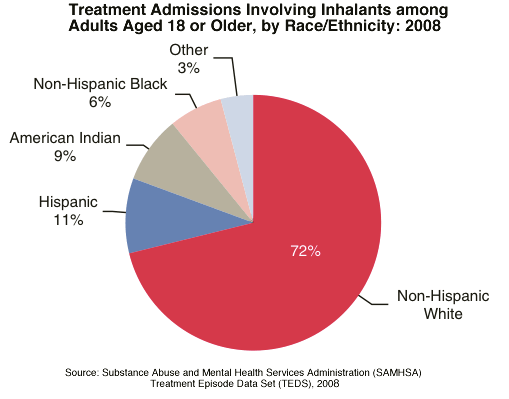Ethnicity and Social Factors
 Data from the literature varies regarding ethnicity and inhalant usage; Mosher,
Rotolo, Krupski, & Stark (2004) found that race/ethnicity was a strong predictor
of lifetime prevalence of inhalant use, with Native-American youth being particularly
likely to use inhalants.
Data from the literature varies regarding ethnicity and inhalant usage; Mosher,
Rotolo, Krupski, & Stark (2004) found that race/ethnicity was a strong predictor
of lifetime prevalence of inhalant use, with Native-American youth being particularly
likely to use inhalants.
Conversely, Beauvais et
al. (2002) found that inhalant use among American Indian adolescents has
decreased over the last decade. They did find that a number
of social and perceptual factors correlate with inhalant use across
Mexican American, American Indian and non-Latino adolescents. Peer factors
appear dominant, although they are somewhat less important for Mexican American
and Indian youth. Increased perception of harm reduced inhalant amongst all
groups.
"People from both urban and rural settings abuse inhalants. Further, research on factors contributing to inhalant abuse suggests that adverse socioeconomic conditions, a history of childhood abuse, poor grades, and school dropout are associated with inhalant abuse."•
©RnCeus.com
 Data from the literature varies regarding ethnicity and inhalant usage; Mosher,
Rotolo, Krupski, & Stark (2004) found that race/ethnicity was a strong predictor
of lifetime prevalence of inhalant use, with Native-American youth being particularly
likely to use inhalants.
Data from the literature varies regarding ethnicity and inhalant usage; Mosher,
Rotolo, Krupski, & Stark (2004) found that race/ethnicity was a strong predictor
of lifetime prevalence of inhalant use, with Native-American youth being particularly
likely to use inhalants.